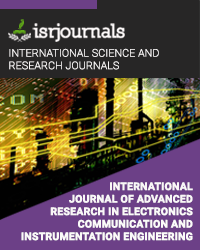an adaptive protocol for industrial and control application using wireless sensor networks k
k.Saranya,M.Aarthi
Published in International Journal of Advanced Research in Electronics, Communication & Instrumentation Engineering and Development
ISSN: 2347 -7210 Impact Factor:1.9 Volume:1 Issue:1 Year: 08 November,2013 Pages:29-36

Abstract
An energy-efficient, reliable and timely data transmission is essential for wireless sensor networks (WSNs) employed in scenarios where plant information must be available for control applications. To reach a maximum efficiency, cross layer interaction is a major design paradigm to exploit the complex interaction among the layers of the protocol stack. This is challenging because latency, reliability, and energy are at odds, and resource constrained nodes support only simple algorithms.The novel protocol Breath is proposed for control applications. Breath is designed for WSNs where nodes attached to plants must transmit information via multi-hop routing to a sink. Breath ensures a desired packet delivery and delay probabilities while minimizing the energy consumption of the network. The protocol is based on randomized routing, medium access control, and duty-cycling jointly optimized for energy efficiency. The design approach relies on a constrained optimization problem, whereby the objective function is the energy consumption and the constraints are the packet reliability and delay. The challenging part is the modeling of the interactions among the layers by simple expressions of adequate accuracy, which are then used for the optimization by in-network processing. The optimal working point of the protocol is achieved by a simple algorithm, which adapts to traffic variations and channel conditions with negligible overhead. The protocol has been implemented and experimentally evaluated on a test-bed with off-the-shelf wireless sensor nodes, and it has been compared with a standard IEEE 802.15.4 solution. Analytical and experimental results show that Breath is tunable and meets reliability and delay requirements. Breath exhibits a good distribution of the working load, thus ensuring a long lifetime of the network. Therefore, Breath is a good candidate for efficient, reliable, and timely data gathering for control applications
Kewords
Breath exhibits a good distribution of the working load
Reference
1] P. Park, C. Fischione, A. Bonivento, K. H. Johansson, and A. Sangiovanni-Vincentelli, “Breath: a self-adapting protocol for wireless sensor networks in control and automation,” in IEEE SECON, 2008. [2] A. Willig, K. Matheus, and A. Wolisz, “Wireless technology in industrial networks,” Proceedings of the IEEE, vol. 93, no. 6, pp. 1130–1151, 2005. [3] A. Willig, “Recent and emerging topics in wireless industrial communication,” IEEE Transactions on Industrial Informatics, vol. 4, no. 2, pp. 102–124, 2008. [4] V. C. Gungor and G. P. Hancke, “Industrial wireless sensor networks: Challenges, design principles, and technical approaches,” IEEE Transactions on Industrial Electronics, vol. 56, no. 10, pp. 4258–4265, 2009. [5] IEEE 802.15.4 Std: Wireless Medium Access Control (MAC) and Physical Layer (PHY) Specifications for Low-Rate Wireless Personal Area Networks (WPANs), IEEE, 2006. [Online]. Available: http://www.ieee802.org/15/pub/TG4.html [6] A. Bonivento, L. Carloni, and A. Sangiovanni-Vincentelli, “Platformbased design for wireless sensor networks,” Mobile Netw. Appl., vol. 11, no. 4, pp. 469–485, 2006. [7] A. Sangiovanni-Vincentelli, “Quo vadis, SLD? reasoning about the trends and challenges of system level design,” Proceedings of the IEEE,vol. 95, no. 3, pp. 467–506, 2007. [8] J. P. Hespanha, P. Naghshtabrizi, and Y. Xu, “A survey of recent results in networked control systems,” Proceedings of the IEEE, vol. 95, no. 1, pp. 138–162, 2007. [9] W. Zhang and M. S. Branicky and S. M. Phillips, “Stability of Networked Control Systems,” IEEE Control Systems Magazine, vol. 21, pp. 84–99, 2001. [10] L. Schenato, B. Sinopoli, M. Franceschetti, K. Poola, and S. Sastry, “Foundations of control and estimation over lossy networks,” Proceedings of the IEEE, vol. 95, no. 1, pp. 163–187, 2007. [11] E. Witrant, P. Park, M. Johansson, C. Fischione, and K. H. Johansson, “Predictive control over wireless multi-hop networks,” in IEEE MSC, 2007. [12] C. Intanagonwiwat, R. Govindan, and D. Estrin, “Directed diffusion: A scalable and robust communication paradigm for sensor networks,” in ACM MobiCom, 2000. [13] Tmote Sky Data Sheet, Moteiv, San Francisco, CA, 2006. [Online]. Available: http://www.moteiv.com/products/docs/tmote-sky-datasheet. pdf [14] P. Buonadonna, D. Gay, J. Hellerstein, W. Hong, and S. Madden, “TASK: Sensor

